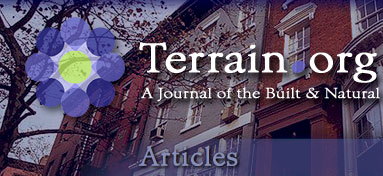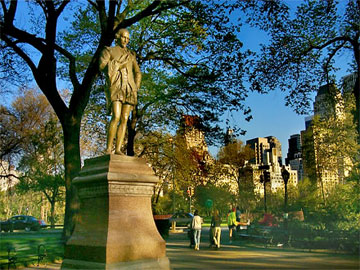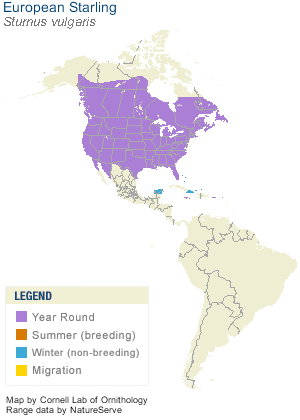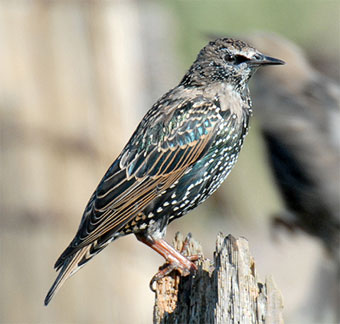
 |
|
|
by Charles Mitchell Act 1: Shakespeare in His Natural Habitat It was 1890 and Shakespeare was in trouble in America. Though still a production staple of the major metropolitan theatrical companies, performances of his plays had declined significantly in number since before the Civil War. One critic, writing in 1882, reached a distressing conclusion: “Shakespeare was heard ten times in New York then [1840] for once that he is heard now.”1 The statue of Shakespeare in Central Park’s Literary Walk was planned to commemorate the 1864 tri-centennial of his birth, but the work was not completed until 1872. Leading Shakespearean actors had so thoroughly personalized their performances that theatergoers familiar with the texts of the plays were left disoriented. In 1884, Mark Twain committed virtual blasphemy by relegating the performance of Shakespeare to the King and the Duke, those unscrupulous rapscallions who hijacked Huck Finn’s raft trip down the Mississippi River.  William Shakespeare statue in Central Park's Literary Walk, New York City. Photo by New York Focus, LLC, courtesy CentralPark 2000.com. The setting of Twain’s novel—in that putative golden age of Shakespearean performance, the 1840s—neatly captures the Bard’s shifting place in American culture. For to be sure, engagements like those lampooned in Adventures of Huckleberry Finn comprised a large share of pre-War performances whose dwindling the critics mourned. Before he became Shakespeare-of-the-English-Department he was Shakespeare-of-the-stage, and for most of the 19th century the stage was a popular democratic medium. In urban theaters, working class “toughs” mingled with more refined patrons at performances that interspersed scenes from Shakespeare with contemporary farces and other “entertainments,” in a setting more evocative of Vaudeville than Shakespeare in the Park. Rural audiences throughout the South and Midwest—like those in Twain’s novel—were familiar enough with Shakespeare to know when they were being hoodwinked. Alexis de Tocqueville, that most indispensable of 19th century chroniclers, famously observed: “There is hardly a pioneer hut in which the odd volume of Shakespeare cannot be found. I remember reading the feudal drama Henry V for the first time in a log cabin.”2 In the decades after the Civil War, Shakespeare disappeared from those log cabins as his plays evolved from broadly popular performances before diverse audiences into a staple of elite, didactic culture. By the end of the century he was the property of those connoisseurs of taste and decorum for whom high culture was both a signifier of upper-class status and a means of civilizing the barbaric masses. The process was subtle but severe and unfolded as a kind of domestication. First, Shakespeare was to be rescued from the grubby clutches of those unworthy masses, who provided an environment too hostile for the delicate flowers of iambic pentameter. Then, he was to be safely installed in the gilded palaces of the elite, surrounded by the well-dressed, the well-coiffed and the well-heeled. Like the flowers and animals transplanted from the wild into private gardens and menageries, Shakespeare was plucked from his natural habitat—the raucous, topsy-turvy world of Elizabethan theater reconstituted in America’s19th century public entertainments—and secured within a carefully managed and manicured House of Culture. This disappearance of Shakespeare from the popular stage prompted the critic A. C. Wheeler to publish “The Extinction of Shakespeare” in 1890.3 Yet while Wheeler and other critics longed for Shakespeare to regain his former popularity, they did not envision a return to the truncated, mixed entertainments that had been the foundation of that popularity. If the vulgar Shakespeare of the working class playhouse was extinct, then good riddance. It was the Shakespeare of the black tie theater, the newly enshrined icon of highbrow culture, whose endangered status was a cause for concern. This was the great paradox of cultural hierarchy. For the masses to enjoy Shakespeare on their own terms was to diminish him: popularity was the very opposite of refinement, and by 1890 Shakespeare was the embodiment of refined taste. But the masses nonetheless needed to be exposed to the moralizing force of Shakespeare and other incarnations of high culture in order to be rescued from a life of eternal grubbiness. Like Frederick Law Olmsted’s Central Park and Andrew Carnegie’s Music Hall, Shakespeare would help to civilize those masses. If only they would clean up, put on a tie, and buy a ticket. Act 2: The Bard’s Birds In the same year that A. C. Wheeler warned of Shakespeare’s endangered status (and the same year that construction began on New York City’s Carnegie Hall), Eugene Schieffelin did his small part to ensure that Shakespeare’s rumored extinction was not forever. A German immigrant who had established a prosperous drug manufacturing business in the Bronx, Schieffelin devoted his extracurricular energies to two pursuits that, in a moment of quirky synergy, would dramatically alter the North American landscape. As a committed patron of New York City theater, Schieffelin would certainly have been troubled to read Wheeler’s account of Shakespeare’s looming extinction. Strapping on his tuxedo before heading downtown for a performance of Hamlet, he might have reflected ruefully on what his less fortunate brethren were missing as they indulged the inferior diversions of beer halls and other such pastimes. Schieffelin’s civic participation also included his role as head of the New York branch of the American Acclimatization Society. With branches throughout the country, the Society’s modest goal was to introduce, at the local level, select species of old world birds and plants in order to create a more familiar and comfortable environment for recent immigrants. Surrounded by some of the sights, sounds, and smells of home—at least those emanating from the species that had been successfully acclimatized—the immigrants themselves would adjust that much more easily to their new surroundings, or so the theory went.  Starlings painted by Roger Tory Peterson for Birds of Eastern and Central North America. Image courtesy Houghton Mifflin. Enter the starling, stage left. Under Schieffelin’s guidance, the New York Acclimatization Society adopted as its special task the introduction of all the birds mentioned in the works of William Shakespeare. This was facilitated by the publication in 1871 of The Birds of Shakespeare, an exhaustive survey, with engravings, compiled by James Edmund Harting. Clearly, the goal here was not to provide a more familiar environment for recent immigrants from Elizabethan England. Rather, Schieffelin hoped to fashion an avian context for a fuller appreciation of Shakespeare’s plays. The creation of Shakespeare gardens in the late nineteenth and early twentieth centuries had a similar purpose: to make Shakespeare’s work seem less foreign to a modern audience by providing a picturesque showcase of all his featured flora. But Schieffelin, it seems, was aiming for something more than a park full of Shakespearean tableaux. If the masses could not be induced to hear Shakespeare in the theater, then perhaps they might be seduced by the sounds of Shakespeare’s birds in the park. In March 1890, Schieffelin released sixty European starlings into Central Park; the next year he released an additional forty. Unfortunately, he was a meticulous reader of Shakespeare, or, more likely, of Harting, for while several species of birds enjoyed starring roles in the metaphors and similes of Shakespeare’s verse, the starling is given a single, obscure cameo in Henry IV, Part I. Here is Hotspur: “The king forbade my tongue to speak of Mortimer. But I will find him when he is asleep, and in his ear I’ll holler ‘Mortimer!’ Nay I’ll have a starling shall be taught to speak nothing but Mortimer, and give it to him to keep his anger still in motion” (Act I, Scene 3). Despite this eminently forgettable beginning, the starling would go on to dominate North America’s avian stage, speaking “Mortimer” and more across four time zones and nearly thirty degrees of latitude. The noisy batch of starlings that evicted the pigeons from under my neighbor’s eaves, the starlings I watched from my bathroom window this morning build their nests with the freshly severed stems of my tomato and pepper plants, are direct descendents of Eugene Schieffelin’s effort to bring the soothing, civilizing music of Shakespeare to New York’s huddling masses. Sturnus vulgaris indeed. Act 3: Go West, Young Starling In Shakespeare’s time it appears that starlings were fairly widespread in Europe, if not exactly numerous, ranging from northern Italy to Scandinavia and from Russia to just south of the British Isles. Hotspur’s reference to their ability to mimic human speech would suggest a significant degree of contact between the two species, with the likelihood that starlings were kept as a kind of pet in the centuries before the trade for exotic birds from South America would have displaced them. Even before their importation as cultural ambassadors to the United States, starlings were particularly well adapted to landscapes shaped by human activity. An omnivore preferring a diverse diet of insects, seeds, fruits ,and berries, the starling was a familiar denizen of the urban and agricultural regions of its eponymous continent. Unlike the eagles, kites, and falcons gliding through Shakespeare’s more prolific avian references, the starling was most likely a bird with which the Bard was personally familiar: a squawker outside the doors of the Globe Theater, a nester in the eaves of his gate house in Ireland Yard. Indeed, it may have been this very familiarity, this commonness, that restricted the starling’s role to that of a bit player. Upon their arrival in the United States, Eugene Schieffelin’s wards found an environment much to their liking. Making their nests at first in the nooks and crannies of the Museum of Natural History, the starlings quickly acclimatized themselves to their new home. Most of the other introduced Shakespearean species died off; the starling has enjoyed what is effectively the longest running and most widely traveled show in American theater history. It was wintering in Florida before Prohibition and followed many Americans across the border into Canada shortly after the Eighteenth Amendment took effect. By the end of World War II starlings had reached the West Coast; they were in Alaska by the time Richard Nixon resigned the presidency. In less than 100 years the European starling had spread over the continent and reached a population of more than 200 million, something it took the European American nearly half a millennium to achieve. A modern day Tocqueville would find more starlings perched on the rain gutters of American homes than copies of Shakespeare in the parlor. Indeed, in what Schieffelin would likely consider a pyrrhic victory, more Americans have heard the song of Shakespeare’s bird than have heard the music of Shakespeare himself. The secret to the starling’s success in the New World is really no secret. Equally comfortable foraging for dinner in freshly mown grass, grain fields, and trash-strewn streets, it has found an abundance of culinary offerings in its adopted home. Its bill is equipped with muscles that both pry and clamp, allowing it to spread apart thick clumps of grass to locate reluctant prey: a much more efficient hunting technique than that endowed to most of its competitors. Starlings have also benefited from an abundance of ready-made housing locations. Indiscriminate cavity nesters, they have made full use of the buildings, bridges, and edge-of-clearing trees that are omnipresent features of the North American landscape. Their migratory patterns—first to arrive and last to leave—allow them to compete successfully with other cavity nesting species, an ability greatly enhanced by their aggressive usurpation of nesting sites already claimed by the natives. And they breed like, well, starlings. Laying clutches of 4 to 6 eggs, mated pairs regularly produce two broods a season and occasionally three. For all their fecundity starlings experience strikingly low rates of nestling mortality. In part this results from a form of colonial breeding, where unmated males assist in the care of the young. Starlings are also highly skilled and efficient housekeepers. Perhaps the most effective of their domestic technologies is the timely application to the nest of fresh foliage, like the stems of tomato and pepper plants, which serve as an anti-parasitical fumigant. Not only does this protect the health of nestlings, it also frees up time and energy for feeding that would otherwise have been spent on nest maintenance. With such competitive advantages—healthier homes, more and better-fed children, a willingness to trample on the rights of others—the starling’s rapid colonization of North America appears to be nothing less than its manifest destiny. Act 4: There Goes the Neighborhood History, of course, is written by the winners, and the tribe of starling can proudly boast of its successes. However, just as the Iroquois and the Sioux might wish to add a qualifying footnote or two to Thomas Hart Benton’s celebration of the destiny of his race, the red-bellied woodpecker, Northern flicker, and Eastern bluebird have ample reason to resent their European cousin’s triumph. While the skies over North America are not a zero-sum world, the explosive growth of starling populations has inevitably come at the expense of other residents. Competition with starlings for food and, most importantly, nesting sites has contributed to significant population declines among more than a dozen species, though it remains difficult to isolate the effect of starlings from the role played by habitat loss and pollution. Woodpeckers in particular have a compelling grievance since starlings regularly claim the homes they have assiduously labored to excavate. Of course, European Americans established a precedent for just such an act of appropriation when Andrew Jackson forcibly removed the Cherokee not simply from their land but from the modern homes they had so dutifully constructed. Perhaps starlings mimic more than the human voice. While certainly regrettable to those who watch birds, hug trees, and recycle rainwater, the starling’s impact on avian ecology is a minor blip on the radar of national concerns. Far more worrisome is the threat starlings pose to frequent flyers, farmers, and the outdoor wedding industry. The 1989 film version of Robert Harling’s Steel Magnolias opens with Tom Skerritt’s character firing his gun into a tree in order to disperse the starlings poised to spoil his daughter’s wedding reception. While the thought of Julia Roberts getting pelted with guano on her big day might be enough to drive even the most fervent pacifist to take up arms, the problem of roosting starlings is not merely a lifestyle nuisance for the eccentric and glamorous. Flocks of starlings numbering in the thousands are common and some have been estimated to include more than 200,000 individuals, enough to induce Hitchcockian nightmares in Roger Tory Peterson.  The range of the European starling in North America through 2009. Image courtesy the Cornell Lab of Ornithology at AllAboutBirds.org. Especially outside of breeding season, when females join the males, large flocks of starlings regularly return at night to roost in the same trees. Naturally, this poses a sanitation problem if the roosting tree happens to be adjacent to a public area. Along the two block Commons in Ithaca, New York, green-haired adolescents and tweed-jacketed academics share the common plight of dodging the droppings of the thousands of starlings that perch overhead. Many an al fresco dinner has been disrupted by the telltale plop in the glass of chardonnay. Plastic owls and real live hawks have provided no deterrent to the starlings’ simple insistence on tree-top tenement living. Roosting starlings also contribute to noise pollution, given their propensity to break into a cacophony of screeching at dawn and dusk. Finding the twice-daily din outside his bedroom window to be unbearable, a friend of mine spent hundreds of dollars trying to drive the nightly roost out of his backyard trees. He tried thinning the branches, installed netting, and set up solar-powered owls to frighten the starlings off. In the end, he cut down the trees and now complains about the lack of shade. What has earned starlings an official “nuisance animal” designation from the federal government, however, has been their impact on aviation and agriculture. Between 1990 and 2001, according to the Federal Aviation Administration, there were 1,704 reported “strikes” of aircraft to flocking blackbirds. Exactly half of these reports identified starlings as the culprit while the majority of the remaining half refer only to generic “blackbirds.” Apparently, a copy of the Audubon Society Field Guide to North American Birds is not standard issue equipment for pilots. Nonetheless, it is likely that starlings were involved in most of the other incidents as well. The number of blackbird strikes over that time grew at a steady if modest pace, from 100 to 160 per year. While collisions with larger species, such as Canadian Geese, are far more costly and occasionally result in crashes and fatalities, starlings have still been responsible for close to two million dollars worth of damage to the civil aviation industry since 1990. Appearances to the contrary notwithstanding, starlings have not been trained by terrorists to disrupt air travel in some bastardization of Day of the Dolphin. Rather, they find airports to be naturally attractive homes. Often surrounded by fields or marshes and providing ample structures for nesting and roosting, the modern airport might well have been specially designed to meet the needs of this feathered frequent flyer, offering them the kind of amenities that make those of us who fly coach jealous. Agriculture, however, is where starlings do the most damage. While there is some evidence that they contribute to insect control, they more than make up for that benefit in their taste for grain and sunflower seeds. They are also voracious raiders of feedlots for beef and dairy cattle, having developed a taste for the easy calories available in enriched feed corn. Given the size of their population and their prolific breeding success, containment rather than rollback is the only practical approach to controlling the starling menace. One popular method available to private citizens is the application of a detergent solution to roosts of winter birds. With the insulating power of their feathers compromised, the birds succumb to exposure. However, this is a difficult and, especially in temperate climates, not always effective method. For a more efficient approach, America’s farmers and aviation authorities can turn to the United States Department of Agriculture. The U.S. Department of Agriculture Wildlife Services division is responsible for managing a wide variety of broadly defined problem animals. In 2004 it reported killing 2,767,152 individual animals, from anhingas and badgers to weasels and wolves; methods used included shooting, trapping, poisoning, and “non chemical other.” “Starlings, European” accounted for 2,320,086, or 84%, of the total number of animals killed. While more than 17,000 of Shakespeare’s birds were shot and over 66,000 cage-killed, the vast majority—2,234,571—were dispatched courtesy of DRC-1339, which the USDA describes as an avian toxicant. Since there are no established tolerances for DRC-1339—which means nobody knows what effect it might have on humans—its use is, we are assured, carefully regulated to minimize the chance of its entering the food chain or affecting “non-target species.” Shakespeare, Schieffelin, and the starling might find it a dubious honor that DRC-1339, when freed of its bureaucratic nomenclature, is known as Starlicide. It is a wonder that conservative academics, who have made something of a cottage industry condemning the Modern Language Association for its eradication of Shakespeare from the curriculum, have not expressed outrage at this murderous conspiracy. Act 5: Starlings are Us  Chandos portrait of William Shakespeare, artis and authenticity unconfirmed. Image courtesy National Portrait Gallery, London. I like bluebirds and flickers; while I have never seen one I am sure I would like Gila woodpeckers, whose numbers are declining at least in part because starlings evict them from the homes they have carved into saguaro cacti. As much as the next guy, I hate seeing a good glass of wine spoiled by starling poop. I had plans for those tomatoes and peppers: gazpacho, maybe, or a roasted salsa recipe I have been looking forward to trying. For these and many other reasons I could rage against the imbecility of Schieffelin, the arrogance behind his peculiar blend of cultural and ecological imperialism. What would my yard, my park, my skies look like if he had not been such a fool? What else would the Wildlife Services division be doing with its time and my tax dollars? I could offer the obvious condemnation of the starling as an invasive species, though in this case the invasion was by invitation. I could say, simply, that starlings do not belong here and allow the righteousness of my outrage to be the final word. But the fact is that starlings are here, and all the Starlicide in the world will not change that. And, as I learned from my German-American grandmother—whose parents were released into New York City in the late 19th century—one should be cautious when deciding who does and who does not belong. If starlings do not belong here, then neither do I. Starlings are here in North America because they mimic human speech. Had they not attached themselves to Homo sapiens’ coattails and started chattering in English, Shakespeare would have had to come up with a different line for Hotspur and the starling would never have passed through Ellis Island. Once they arrived on these shores their success was guaranteed because they were so much like us in other ways as well, willing to live where we live, eat what we eat, and follow us wherever we might go. Unwillingly and unwittingly we have played Squanto and Sacajawea to the starling invaders, helping to pave the way for a success we have come to regret. The only two landscapes they have not successfully colonized are forested wilderness areas and open desert, the two landscapes with the lowest human population density (one by definition, the other by default). In short, where there are people there are starlings. And it is not just the opportunism and adaptability of their behavior that defines our kinship. During nesting season, while mom spends the night on the nest, dad flies off to join the boys in the roost, whooping it up like a convention of Promise Keepers at a monster truck rally. You can’t get any more American than that. To complain about starlings would be hypocritical and ungenerous, but it would be irresponsibly glib for us to dismiss the damage they have done with an Alfred E. Neuman shrug. Of course, I could spend pages unpacking, repacking, and unpacking again the meaning of the word “damage” in this context, and my unauthorized use of the first person plural pronoun is bound to raise some postructuralist eyebrows. At the very least, the folks at starlingtalk.com—a website devoted to championing the starling’s virtues and defending its honor—would find both “damage” and “us” to be fighting words. But if controlling starlings falls somewhere between the impractical and the impossible—and all but the hardcore Dr. Strangeloves at the USDA have admitted as much—then all that may be left to us is to learn to live with them. While I don’t share the enthusiasm of the folks at starlingtalk.com for keeping starlings as pets, their uncomplicated acceptance of the reality of starlings is refreshing. Even Rachel Carson wondered in a 1939 essay for Nature Magazine whether it was time to grant the starling citizenship papers, an argument that has much to teach today’s “immigration reform” advocates. The space we make for starlings may say something about the space we allow ourselves, all of our selves. The starling came to us as a character in a tragedy, and the tragedy is that efforts to mitigate the impact of starlings on native species are unlikely to be more than nominally successful. A few carefully designed and tended nest boxes might lure a few more bluebirds, but isolated local victories may be all we can hope for. That is the nature of tragedy. Things did not work out too well for Hotspur and Mortimer, either. But Shakespeare was not all tragedy. His comedies suggest that merriment can be had, and happiness won, even under the least idyllic of circumstances. Hermia and Lysander avoid the path of Romeo and Juliet thanks to a midsummer night’s frolic in the woods; Bottom’s ass finds love with Titania. Any extraneous detail can be accommodated, any alien creature can find love, with a little imagination exercised under the open air. Balance is not so much restored as re-imagined.  The European starling. Image courtesy Whidbey Audubon Society. Epilogue: Oh Brave, New World That Has Such Starlings In It It is a dreamy midsummer day. I am midsummering in a hammock in my friends’ backyard in northwestern New Jersey, a backyard that includes ten acres, a barn, and a pond. Struggling to stay focused on James Fenimore Cooper’s The Pioneers, which I will soon decide not to teach in the fall semester, I turn frequently to watch the barn swallows (what were they called before we invented barns?) skim their lunch off the surface of the pond. Above the tree line 200 yards away I see a handful of blackbirds crossing from stage right. Then a bucketful. Through binoculars I identify starlings. They keep coming. Soon, thirty degrees of my sky are filled with starlings. Renegade pockets angle out of the mainstream, circle back, and then seamlessly reintegrate themselves like water in an eddy. This goes on for seventeen minutes. I know that there are experts somewhere who could calculate the number of individual birds I saw that afternoon, but I do not care to know. What is of interest to me is that for those seventeen minutes I could imagine what it might have been like to stand with Natty Bumpo under a sky full of passenger pigeons. Now I know that starlings are not passenger pigeons. They do not make up for the extinction of passenger pigeons any more than the New York Mets made up for the loss of the Brooklyn Dodgers. But they are what we have now. And, at times, they can be amazing.
Post Comment
|
|
||||||||||||||||||||||||||||||||||||||||||||||||||||||||||||||